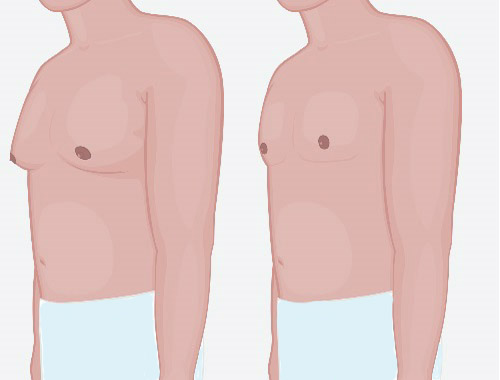Gynecomastia

Published: 18 Jun 2025
ICD9: 611.1 ICD10: N62 ICD11: GB22
Gynecomastia is a condition in which men develop enlarged breast tissue.
It's not the same as chest fat (pseudogynecomastia). Gynecomastia involves the actual growth of glandular breast tissue.
Here's a breakdown of important aspects:
![]() Cause: It's primarily caused by an imbalance in the hormones estrogen and testosterone. Higher levels of estrogen relative to testosterone can stimulate breast tissue growth.
Cause: It's primarily caused by an imbalance in the hormones estrogen and testosterone. Higher levels of estrogen relative to testosterone can stimulate breast tissue growth.
![]() Who it affects: It can affect males of all ages, including newborns, adolescents during puberty, and older men.
Who it affects: It can affect males of all ages, including newborns, adolescents during puberty, and older men.
![]() Common Causes:
Common Causes:![]()

![]() Hormonal changes: Puberty, aging, and certain medical conditions.
Hormonal changes: Puberty, aging, and certain medical conditions.![]()

![]() Medications: Some medications, such as anabolic steroids, anti-androgens, certain antidepressants, and some heart medications, can cause it.
Medications: Some medications, such as anabolic steroids, anti-androgens, certain antidepressants, and some heart medications, can cause it.![]()

![]() Medical conditions: Kidney failure, liver disease, hyperthyroidism, tumors, and Klinefelter syndrome.
Medical conditions: Kidney failure, liver disease, hyperthyroidism, tumors, and Klinefelter syndrome.![]()

![]() Illicit drug use: Marijuana, alcohol, and heroin.
Illicit drug use: Marijuana, alcohol, and heroin.![]()

![]() Herbal products: Certain products containing estrogenic compounds.
Herbal products: Certain products containing estrogenic compounds.
![]() Symptoms:
Symptoms:![]()

![]() Swollen breast tissue.
Swollen breast tissue.![]()

![]() Tenderness or pain in the breasts.
Tenderness or pain in the breasts.![]()

![]() Lump under the nipple.
Lump under the nipple.![]()

![]() Sometimes, nipple discharge (less common).
Sometimes, nipple discharge (less common).
![]() Diagnosis: A physical examination and medical history are usually sufficient. In some cases, blood tests to check hormone levels or a mammogram might be necessary to rule out other conditions.
Diagnosis: A physical examination and medical history are usually sufficient. In some cases, blood tests to check hormone levels or a mammogram might be necessary to rule out other conditions.
![]() Treatment:
Treatment:![]()

![]() Observation: In some cases, especially during puberty, gynecomastia may resolve on its own.
Observation: In some cases, especially during puberty, gynecomastia may resolve on its own.![]()

![]() Medications: Medications like selective estrogen receptor modulators (SERMs) can be prescribed to block the effects of estrogen.
Medications: Medications like selective estrogen receptor modulators (SERMs) can be prescribed to block the effects of estrogen.![]()

![]() Surgery: In severe or persistent cases, surgery (mastectomy or liposuction) may be considered to remove excess breast tissue.
Surgery: In severe or persistent cases, surgery (mastectomy or liposuction) may be considered to remove excess breast tissue.
![]() Important Note: It's crucial to consult a doctor to determine the underlying cause of gynecomastia and to discuss appropriate treatment options. While it's often benign, it's important to rule out any underlying medical conditions.
Important Note: It's crucial to consult a doctor to determine the underlying cause of gynecomastia and to discuss appropriate treatment options. While it's often benign, it's important to rule out any underlying medical conditions.
In summary, Gynecomastia is the enlargement of breast tissue in males due to a hormonal imbalance, medications, or other underlying conditions. Diagnosis involves physical examination and possibly blood tests, and treatment ranges from observation to medication or surgery depending on the cause and severity.